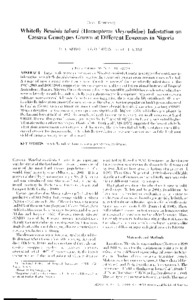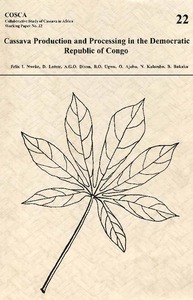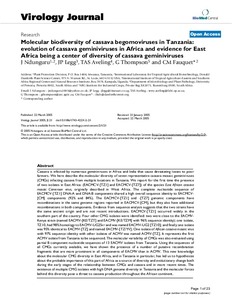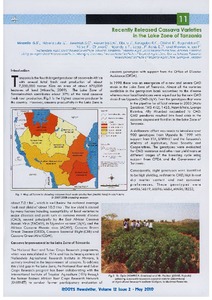| dc.contributor.author | Ariyo, O. |
| dc.contributor.author | Dixon, A. |
| dc.contributor.author | Atiri, G. |
| dc.date.accessioned | 2019-12-04T11:19:02Z |
| dc.date.available | 2019-12-04T11:19:02Z |
| dc.date.issued | 2005 |
| dc.identifier.citation | Ariyo, O., Dixon, A. & Atiri, G. (2005). Whitefly Bemisia tabaci (Homoptera: Aleyrodidae) infestation on cassava genotypes grown at different ecozones in Nigeria. Journal of Economic Entomology, 98(2), 611-617. |
| dc.identifier.issn | 0022-0493 |
| dc.identifier.uri | https://hdl.handle.net/20.500.12478/3380 |
| dc.description.abstract | Large-scale screening of cassava, Manihot esculenta Crantz, genotypes for resistance to infestation by whitefly Bemisia tabaci Gennadius, the vector of cassava mosaic geminiviruses, is limited. A range of new cassava elite clones were therefore assessed for the whitefly infestation in the 1999/2000 and 2000/2001 cropping seasons in experimental fields of International Institute of Tropical Agriculture, Ibadan, Nigeria. On each scoring day, between 0600 and 0800 hours when the whiteflies were relatively immobile, adult whitefly populations on the five topmost expanded leaves of cassava cultivars were counted. All through the 6-mo scoring period, there was a highly significant difference in whitefly infestation among the new cassava elite clones. Vector population buildup was observed in Ibadan (forest–savanna transition zone) and Onne (humid forest), 2 mo after planting (MAP). Mean infestation across cassava genotypes was significantly highest (16.6 whiteflies per plant) in Ibadan and lowest in Zaria (0.2). Generally, whitefly infestation was very low in all locations at 5 and 6 MAP. During this period, cassava genotypes 96/1439 and 91/02324 significantly supported higher infestations than other genotypes. Plants of 96/1089A and TMS 30572 supported the lowest whitefly infestation across cassava genotypes in all locations. The preferential whitefly visitation, the differences between locations in relation to whitefly population, cassava mosaic disease, and the fresh root yield of cassava genotypes are discussed. |
| dc.language.iso | en |
| dc.subject | Whitefly Infestation |
| dc.subject | Cassava Genotypes |
| dc.subject | Cassava Mosaic Geminiviruses |
| dc.subject | Resistance |
| dc.subject | Cassava Elite Clones |
| dc.subject | African Cassava Mosaic Virus |
| dc.title | Whitefly Bemisia tabaci (Homoptera: Aleyrodidae) infestation on cassava genotypes grown at different ecozones in Nigeria |
| dc.type | Journal Article |
| dc.description.version | Peer Review |
| cg.contributor.affiliation | International Institute of Tropical Agriculture |
| cg.contributor.affiliation | University of Ibadan |
| cg.coverage.region | Africa |
| cg.coverage.region | West Africa |
| cg.coverage.country | Nigeria |
| cg.isijournal | ISI Journal |
| cg.authorship.types | CGIAR and developing country institute |
| cg.iitasubject | Cassava |
| cg.iitasubject | Pests Of Plants |
| cg.iitasubject | Disease Control |
| cg.iitasubject | Plant Genetic Resources |
| cg.iitasubject | Plant Breeding |
| cg.iitasubject | Plant Diseases |
| cg.iitasubject | Plant Production |
| cg.iitasubject | Farm Management |
| cg.iitasubject | Genetic Improvement |
| cg.iitasubject | Handling, Transport, Storage And Protection Of Agricultural Products |
| cg.iitasubject | Livelihoods |
| cg.accessibilitystatus | Limited Access |
| local.dspaceid | 95054 |
| cg.identifier.doi | https://dx.doi.org/10.1603/0022-0493-98.2.611 |




